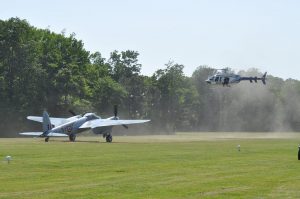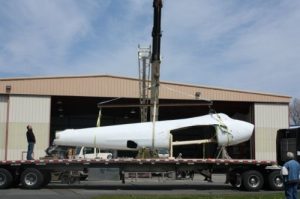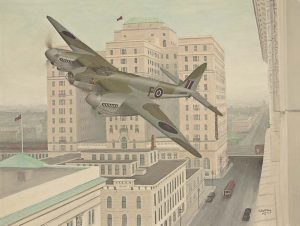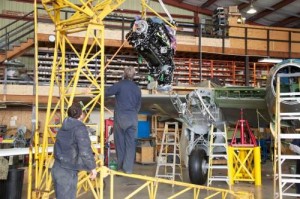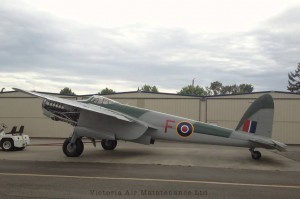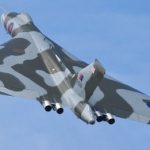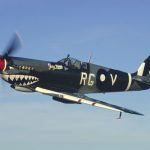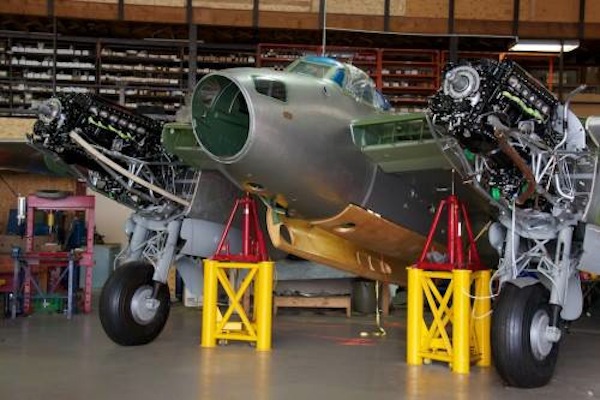
(Image Credit: Victoria Air Maintenance, Ltd.)
In the comments section for our recent story on the first flight of the world’s only flying Mosquito, Warbirds News reader Paul Smith, tipped us off about another Mosquito that will soon be returning to the air. In a long-running restoration effort the crew at Victoria Air Maintenance, Ltd. in North Saanich, near Victoria, British Columbia have gotten a de Havilland Mosquito whipped into shape in preparation for a return to the skies over western Canada.
Mosquito from a helicopter, earlier this year.
While not as famous as some of the other allied aircraft of the second world war, the Mosquito is perhaps for Britons the most important plane of the war, at least according to a recent BBC Channel 4 UK documentary “The Plane that Saved Britain,” which just aired and included a film crew pilgrimage to Virginia Beach to the Military Aviation Museum to film the sole airworthy Mosquito in action. The documentary asserts that while the Supermarine Spitfire and Hawker Hurricane are remembered as the machines that saved Britain from Nazi invasion in the Battle of Britain, and the Avro Lancaster and Handley Page Halifax are revered as the bombers that took the fight to the enemy, the greatest British aircraft of World War II was the less-appreciated Mosquito, which served with distinction as a fighter, a bomber, a U-boat hunter and a night fighter as well as a reconnaissance plane and a pathfinder for large scale bombing runs.
The two man plane’s greatest attribute, it’s speed, was a result of its unique construction, born from the wartime need to conserve metals which were in short supply, leading to a plane largely constructed from wood. The Mosquito’s fuselage was crafted in workshops turned over from furniture and cabinet-making from spruce, birch, balsa and plywood, were then put together with glue. The resultant plane was one of the fastest planes in the world when it entered production in 1941.
(Image Credit: Victoria Air Maintenance, Ltd.)
Its wood construction provided it’s greatest strength during the war, but was also its Achilles’ heel. While metal aircraft endured after the war, Mosquitos rotted away, between the wood decomposing and the loss of adhesion of the animal-based glues that held the plywood together, few Mosquitos survived long and very few remained airworthy to display on the air show circuits of the world, which caused the plane to fall to an undeserved level of obscurity. In fact, in interviews relating to the Military Aviation Museum’s Mosquito, Yagen stated it was the extreme challenge of the restoration and the lack of survivors that inspired him to take on the project in the first place.
(Image Credit: Calgary Mosquito Society)
Without a doubt one of the most beautiful planes of the era, the end of the war saw them come home with the air forces that campaigned them, notably the Royal Canadian Air Force. One particular plane, Mosquito LR503, known as “F for Freddie,” late of 105 Squadron and survivor of 213 operations over occupied Europe, more operational sorties than any other allied bomber during World War II, captured the imagination of the Canadian public. Flown by combat decorated heros, the plane performed in a war bonds tour of Canada, famously performing an astounding aerobatic demonstration over (and through) Calgary on May 9, 1945 in celebration of the war’s end in Europe, shooting under low bridges and buzzing down avenues below building roof height. RCAF staff working on the sixth floor of the Hudson Bay building recall having to look down to see the Mosquito streaking past below their windows at over 300MPH.
(Image Credit: Victoria Air Maintenance, Ltd.)
The day after its famous buzzing of Calgary, the Mossie and her crew were scheduled to make flights over Penhold, Alberta, 80 miles to the north, then south to the RCAF bases at Lethbridge and Medicine Hat, before returning to Calgary for the night. During a series of extremely low and fast buzzes of the control tower at Calgary at the beginning of the day that saw the plane flying straight for the tower at near 400MPH at a level below the observation windows, and pulling up at the last possible moment, the plane struck the steel anemometer tower and flag pole atop the control tower, severing the Mosquito’s port wing and horizontal stabilizer from the airplane. The upward angle and high speed carried “Freddie” and its crew over the surrounding buildings and into a field almost half a mile from the terminal building. The plane struck ground at a shallow angle and exploded into flames, trailing wreckage and igniting the grass for over 300 yards and killing her crew.
(Image Credit: Victoria Air Maintenance, Ltd.)
Starting from just a shell and assorted components, the crew at Victoria Air Maintenance have painstakingly created a working Mosquito, wearing the markings and colors of “F for Freddie” in honor of the accomplished plane and her heroic crew of Maurice Briggs and John C. Baker, who after distinguished wartime flying careers tragically met their end on the home front. The plane, now with freshly-rebuilt Rolls-Royce Merlin engines installed, major systems in place and paint work in progress, should be returning to the skies soon, the world’s second flying de Havilland Mosquito.








